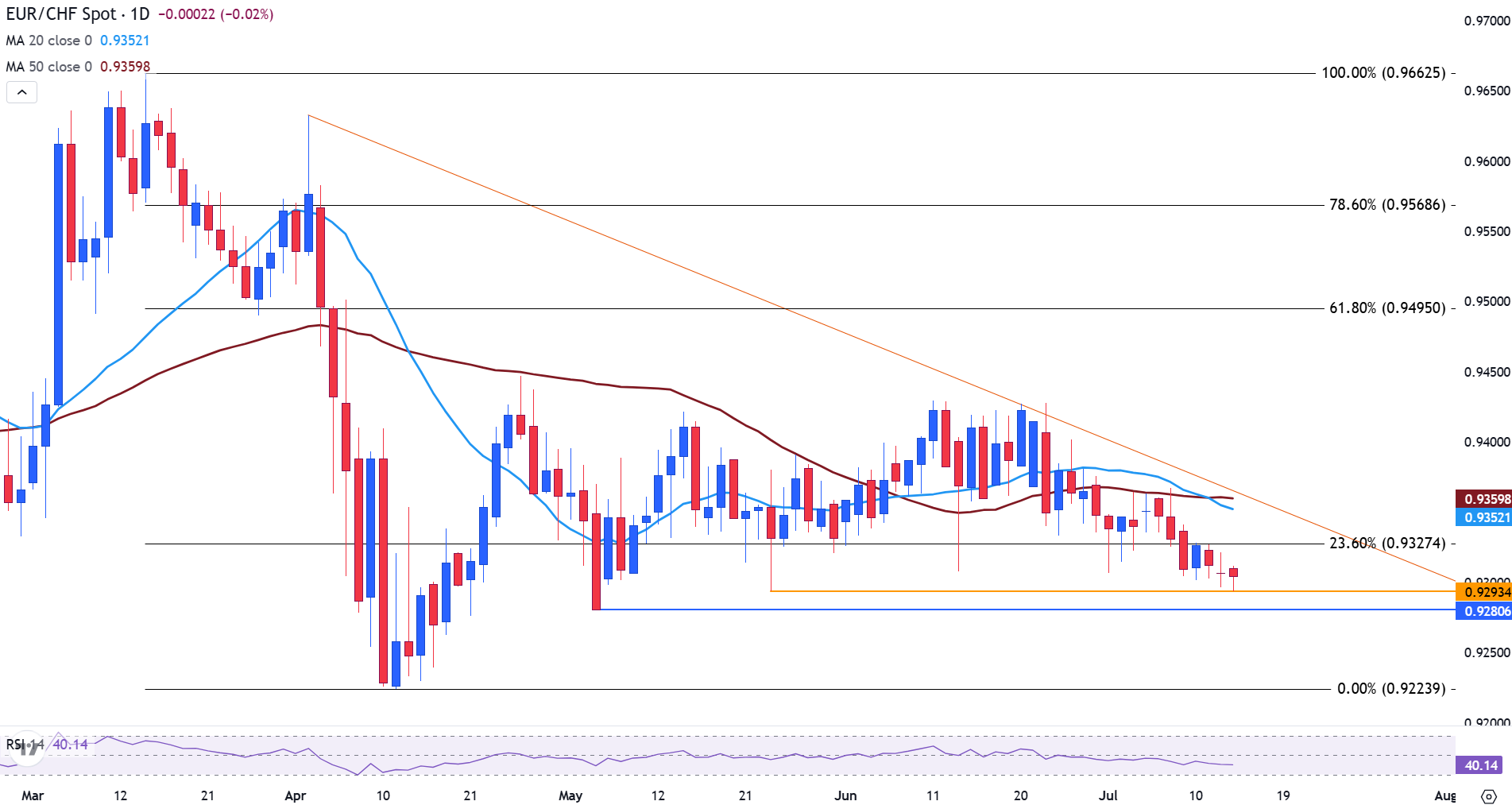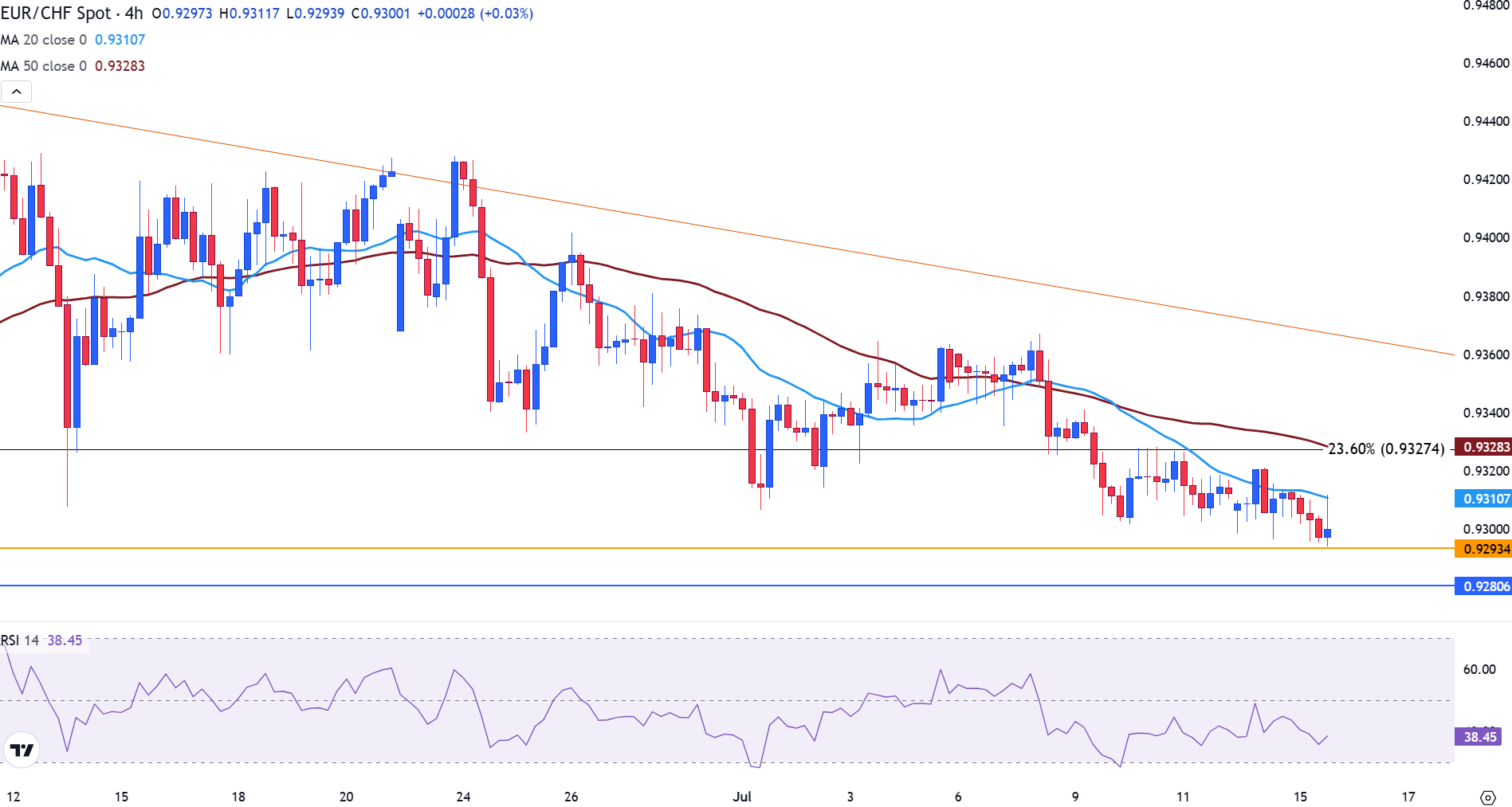EUR/CHF Price Forecast: Bearish structure holds as pair hovers near 0.9300
- EUR/CHF remains locked in a descending triangle pattern, with price consolidating around 0.9300.
- The Euro remains under pressure against the Swiss Franc due to the bearish structure.
- Momentum indicators continue to reflect that bearish bias remains intact.
The Euro (EUR) is trading in a narrow range against the Swiss Franc (CHF) on Tuesday, with price action consolidating near the 0.9300 mark.
At the time of writing, EUR/CHF remains within a well-defined descending triangle pattern. The price is currently holding above support at 0.9293, the base of the triangle. A confirmed break below this level would expose the May low at 0.9280.
On the daily chart, the technical outlook remains bearish, characterized by a steady sequence of lower highs and lower lows.
If this zone is breached, further downside toward 0.9224 becomes increasingly likely.
Conversely, a move higher that breaks above the immediate resistance at the 23.6% Fibonacci retracement level of the March high-April low move, around 0.9327, could shift short-term sentiment.
Beyond this, a confluence of resistance lies near 0.9352, where the descending trendline intersects with the 20-day Simple Moving Average (SMA), followed by the 50-day SMA at 0.9360. The Relative Strength Index (RSI) on the daily timeframe sits at 41, indicating ongoing bearish pressure without signaling oversold conditions, leaving room for additional downside before a technical rebound becomes likely.

EUR/CHF daily chart
The 4-hour chart reinforces the broader downtrend, showing price action continuing to respect the descending trendline and trading beneath both the 20-period and 50-period SMA, currently at 0.9311 and 0.9328, respectively.
These dynamic resistance levels cap any bullish attempts.
The pair remains supported just above 0.9293, with additional horizontal support at 0.9280, both of which have been tested multiple times. This clustered support zone indicates the market is at a critical juncture, with sellers struggling to force a clean breakdown.
However, if bears succeed in pushing below 0.9280, it could trigger an accelerated decline toward the next major support at 0.9224. On the other hand, a break above 0.9328–0.9330, followed by a close above the descending trendline, would weaken the bearish structure and potentially initiate a move toward 0.9495, aligning with the 61.8% Fibonacci retracement level of the March-April decline.

EUR/CHF 4-hour chart
Euro FAQs
The Euro is the currency for the 19 European Union countries that belong to the Eurozone. It is the second most heavily traded currency in the world behind the US Dollar. In 2022, it accounted for 31% of all foreign exchange transactions, with an average daily turnover of over $2.2 trillion a day. EUR/USD is the most heavily traded currency pair in the world, accounting for an estimated 30% off all transactions, followed by EUR/JPY (4%), EUR/GBP (3%) and EUR/AUD (2%).
The European Central Bank (ECB) in Frankfurt, Germany, is the reserve bank for the Eurozone. The ECB sets interest rates and manages monetary policy. The ECB’s primary mandate is to maintain price stability, which means either controlling inflation or stimulating growth. Its primary tool is the raising or lowering of interest rates. Relatively high interest rates – or the expectation of higher rates – will usually benefit the Euro and vice versa. The ECB Governing Council makes monetary policy decisions at meetings held eight times a year. Decisions are made by heads of the Eurozone national banks and six permanent members, including the President of the ECB, Christine Lagarde.
Eurozone inflation data, measured by the Harmonized Index of Consumer Prices (HICP), is an important econometric for the Euro. If inflation rises more than expected, especially if above the ECB’s 2% target, it obliges the ECB to raise interest rates to bring it back under control. Relatively high interest rates compared to its counterparts will usually benefit the Euro, as it makes the region more attractive as a place for global investors to park their money.
Data releases gauge the health of the economy and can impact on the Euro. Indicators such as GDP, Manufacturing and Services PMIs, employment, and consumer sentiment surveys can all influence the direction of the single currency. A strong economy is good for the Euro. Not only does it attract more foreign investment but it may encourage the ECB to put up interest rates, which will directly strengthen the Euro. Otherwise, if economic data is weak, the Euro is likely to fall. Economic data for the four largest economies in the euro area (Germany, France, Italy and Spain) are especially significant, as they account for 75% of the Eurozone’s economy.
Another significant data release for the Euro is the Trade Balance. This indicator measures the difference between what a country earns from its exports and what it spends on imports over a given period. If a country produces highly sought after exports then its currency will gain in value purely from the extra demand created from foreign buyers seeking to purchase these goods. Therefore, a positive net Trade Balance strengthens a currency and vice versa for a negative balance.

